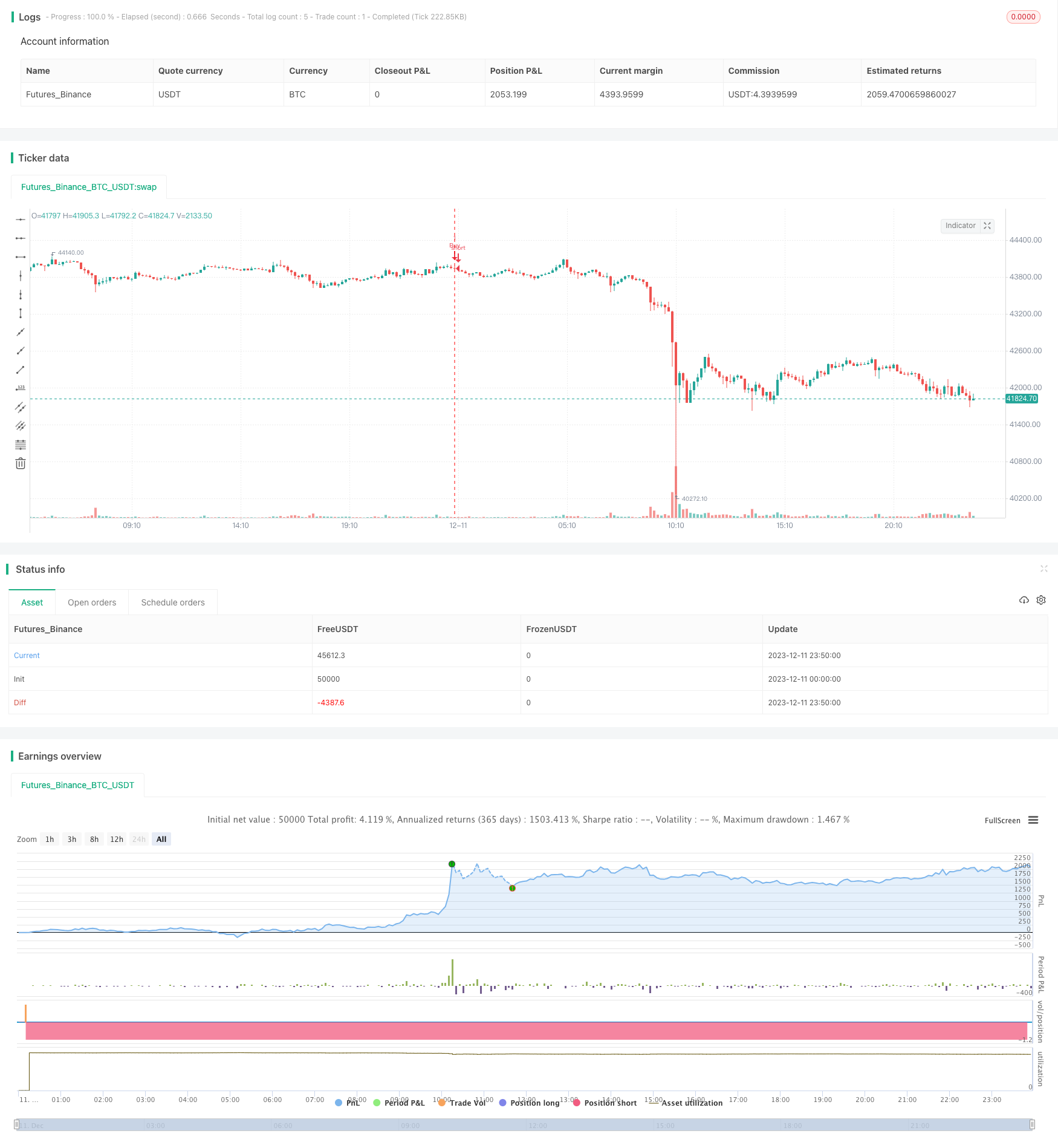価格ショックブレイクアウト戦略

概要
震え突破戦略は,価格の揺れを活用して,価格が重要なサポートまたは抵抗点を突破したときに取引を行う戦略である.この戦略は,複数の技術指標を組み合わせて,重要な取引機会を識別する.
戦略原則
この戦略は,ブリン帯中線,48日単調移動平均 (SMA),MACD,ADXの4つの技術指標に基づいています.具体的論理は以下の通りです.
48日SMAを上下する際に取引の機会を考慮する.
閉店価格がブリン帯の中央線を突破すると,入場信号として;
MACDはトレンドの方向を決定する補助指標として0より大きくまたは小さい.
ADXは25以上で,非トレンドをフィルターします.
4つの条件が満たされた場合,余分な時間や空いた時間を行います.
戦略的優位性
これは,トレンドと振動の指標を組み合わせた戦略です.
48日SMAは過度に頻繁な取引をフィルターし,中長線トレンドをロックします.
ブリン帯中線突破は,重要なサポート抵抗突破点を把握し,強力な止損機能を有する.
MACDは大きなトレンドの方向を判断し,逆転取引を避ける.
ADXは非トレンド市場をフィルターし,戦略の勝率を高めます.
この戦略は,取引頻度を制御し,重要なポイントを把握し,トレンドを判断し,非効率的な状況をフィルターするなど,多くの面で最適化され,勝利率が高い.
戦略リスク
この戦略には以下のリスクがあります.
ブリン・ベルト・ミッドラインは,波動的な市場において,頻繁に取引機会を誘発し,過剰取引を起こす可能性があります.
ADXは,トレンドと無効性を判断する際に,間違いがある.
投資家のリスクは高いので,投資家はリスクを負うことができます.
戦略の最適化
この戦略は,以下の点でさらに最適化できます.
ATRの指標を増やし,ストップポイントを設定し,単発ストップを減らす.
ブリン帯のパラメータを最適化して,中線のトリガの頻度を下げる.
取引量やトレンド強さの指標を増加させることで,トレンドの強さを判断し,弱さの逆転を避ける.
要約する
総括すると,この震突破戦略は全体的に成熟しており,震の状況における重要な取引点を効果的に把握している.傾向と震の指標を組み合わせ,リスクと利益の間のバランスを把握している.さらなる最適化により,より安定した余剰利益が得られる見込みがある.
/*backtest
start: 2023-12-11 00:00:00
end: 2023-12-12 00:00:00
period: 10m
basePeriod: 1m
exchanges: [{"eid":"Futures_Binance","currency":"BTC_USDT"}]
*/
// This source code is subject to the terms of the Mozilla Public License 2.0 at https://mozilla.org/MPL/2.0/
// © 03.freeman
//Volatility Traders Minds Strategy (VTM Strategy)
//I found this startegy on internet, with a video explaingin how it works.
//Conditions for entry:
//1 - Candles must to be above or bellow the 48 MA (Yellow line)
//2 - Candles must to break the middle of bollinger bands
//3 - Macd must to be above or bellow zero level;
//4 - ADX must to be above 25 level
//@version=4
strategy("Volatility Traders Minds Strategy (VTM Strategy)", shorttitle="VTM",overlay=true)
source = input(close)
//MA
ma48 = sma(source,48)
//MACD
fastLength = input(12)
slowlength = input(26)
MACDLength = input(9)
MACD = ema(source, fastLength) - ema(source, slowlength)
aMACD = ema(MACD, MACDLength)
delta = MACD - aMACD
//BB
length = input(20, minval=1)
mult = input(2.0, minval=0.001, maxval=50)
basis = sma(source, length)
dev = mult * stdev(source, length)
upper = basis + dev
lower = basis - dev
//ADX
adxThreshold = input(title="ADX Threshold", type=input.integer, defval=25, minval=1)
adxlen = input(14, title="ADX Smoothing")
dilen = input(14, title="DI Length")
dirmov(len) =>
up = change(high)
down = -change(low)
plusDM = na(up) ? na : (up > down and up > 0 ? up : 0)
minusDM = na(down) ? na : (down > up and down > 0 ? down : 0)
truerange = rma(tr, len)
plus = fixnan(100 * rma(plusDM, len) / truerange)
minus = fixnan(100 * rma(minusDM, len) / truerange)
[plus, minus]
adx(dilen, adxlen) =>
[plus, minus] = dirmov(dilen)
sum = plus + minus
adx = 100 * rma(abs(plus - minus) / (sum == 0 ? 1 : sum), adxlen)
sig = adx(dilen, adxlen)
// Strategy: (Thanks to JayRogers)
// === STRATEGY RELATED INPUTS ===
//tradeInvert = input(defval = false, title = "Invert Trade Direction?")
// the risk management inputs
inpTakeProfit = input(defval = 0, title = "Take Profit Points", minval = 0)
inpStopLoss = input(defval = 0, title = "Stop Loss Points", minval = 0)
inpTrailStop = input(defval = 0, title = "Trailing Stop Loss Points", minval = 0)
inpTrailOffset = input(defval = 0, title = "Trailing Stop Loss Offset Points", minval = 0)
// === RISK MANAGEMENT VALUE PREP ===
// if an input is less than 1, assuming not wanted so we assign 'na' value to disable it.
useTakeProfit = inpTakeProfit >= 1 ? inpTakeProfit : na
useStopLoss = inpStopLoss >= 1 ? inpStopLoss : na
useTrailStop = inpTrailStop >= 1 ? inpTrailStop : na
useTrailOffset = inpTrailOffset >= 1 ? inpTrailOffset : na
// === STRATEGY - LONG POSITION EXECUTION ===
enterLong() => close>ma48 and close>basis and delta>0 and sig>adxThreshold // functions can be used to wrap up and work out complex conditions
//exitLong() => jaw>teeth or jaw>lips or teeth>lips
strategy.entry(id = "Buy", long = true, when = enterLong() ) // use function or simple condition to decide when to get in
//strategy.close(id = "Buy", when = exitLong() ) // ...and when to get out
// === STRATEGY - SHORT POSITION EXECUTION ===
enterShort() => close<ma48 and close<basis and delta<0 and sig>adxThreshold
//exitShort() => jaw<teeth or jaw<lips or teeth<lips
strategy.entry(id = "Sell", long = false, when = enterShort())
//strategy.close(id = "Sell", when = exitShort() )
// === STRATEGY RISK MANAGEMENT EXECUTION ===
// finally, make use of all the earlier values we got prepped
strategy.exit("Exit Buy", from_entry = "Buy", profit = useTakeProfit, loss = useStopLoss, trail_points = useTrailStop, trail_offset = useTrailOffset)
strategy.exit("Exit Sell", from_entry = "Sell", profit = useTakeProfit, loss = useStopLoss, trail_points = useTrailStop, trail_offset = useTrailOffset)
// === Backtesting Dates === thanks to Trost
testPeriodSwitch = input(false, "Custom Backtesting Dates")
testStartYear = input(2020, "Backtest Start Year")
testStartMonth = input(1, "Backtest Start Month")
testStartDay = input(1, "Backtest Start Day")
testStartHour = input(0, "Backtest Start Hour")
testPeriodStart = timestamp(testStartYear,testStartMonth,testStartDay,testStartHour,0)
testStopYear = input(2020, "Backtest Stop Year")
testStopMonth = input(12, "Backtest Stop Month")
testStopDay = input(31, "Backtest Stop Day")
testStopHour = input(23, "Backtest Stop Hour")
testPeriodStop = timestamp(testStopYear,testStopMonth,testStopDay,testStopHour,0)
testPeriod() =>
time >= testPeriodStart and time <= testPeriodStop ? true : false
isPeriod = testPeriodSwitch == true ? testPeriod() : true
// === /END
if not isPeriod
strategy.cancel_all()
strategy.close_all()